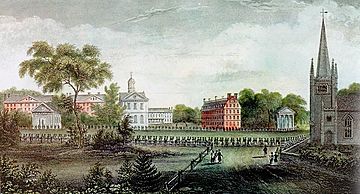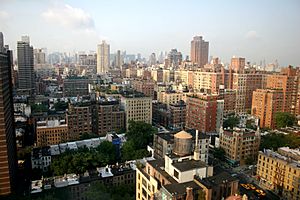White Anglo-Saxon Protestants facts for kids

In the United States, White Anglo-Saxon Protestants or WASPs is a term used to describe white Protestant Americans. They have often been part of the upper-class and historically held a lot of power. WASPs are typically of British descent.
For much of American history, WASPs were very important in society, culture, and politics. Starting in the 1950s, some groups began to criticize their strong influence. Even though their social power has changed since the 1960s, wealthy WASPs still play a big role in American money, government, and helping others.
The term Anglo-Saxon usually means people from British or English backgrounds. However, experts sometimes use WASP more broadly. It can include all Protestant Americans whose families came from Northwestern and Northern Europe. The term WASP is also used for similar powerful groups in Australia, New Zealand, and Canada. Some people find the term "WASP" to be negative or even offensive.
Contents
What Does WASP Mean?
The word Anglo-Saxon refers to people from England before the Norman Conquest in 1066. The term WASP was first used in 1957 by a political scientist named Andrew Hacker. He used 'W' for 'wealthy' instead of 'white'. The 'P' was added to suggest someone who might make sharp or slightly mean comments.
Hacker described this group as "wealthy, Anglo-Saxon in origin, and Protestants." He noted that many were Episcopalian. An earlier use of the term appeared in an African-American newspaper in 1948. Author Stetson Kennedy wrote about WASPs "ganging up to take their frustrations out on whatever minority group happens to be handy."
The term became well-known thanks to sociologist E. Digby Baltzell. He was a WASP himself. In his 1964 book, The Protestant Establishment: Aristocracy and Caste in America, Baltzell said that the WASP upper class was becoming like a closed group or "caste."
WASPs have traditionally been linked with certain Protestant churches. These include Episcopal (or Anglican), Presbyterian, United Methodist, and Congregationalist churches. However, the term has grown to include other Protestant groups too.
Anglo-Saxon in Modern Times
Before WASP became common in the 1960s, the term Anglo-Saxon was used in similar ways. It often referred to the combined influence of Britain and the U.S. Some writers used it negatively, especially those from Ireland or France. For example, French leaders like Charles de Gaulle often wanted to "rid France of Anglo-Saxon influence."
In Australia, Anglo or Anglo-Saxon means people of English background. Anglo-Celtic includes people of Irish, Welsh, and Scottish descent.
Outside of English-speaking countries, Anglo-Saxon is still used to talk about English-speaking people and societies. This includes Britain, the United States, Australia, Canada, and New Zealand.
Other European Backgrounds
Over time, the term WASP has sometimes grown to include more than just English-American Protestants. It can also include American Protestants from other parts of Northwestern Europe. This might mean people of Dutch, Scottish, Welsh, German, or Scandinavian descent.
Some experts say that WASP now includes most white people who are not part of a minority group. This means it can cover Protestant Americans from French Huguenot backgrounds or other Germanic European heritages.
WASP Culture and Lifestyle
Historically, the first Anglo-Protestant settlers in the 1600s were very successful. They held a lot of power in culture, money, and politics until the early 1900s. Many of the wealthiest American families were WASPs. These include groups like the Boston Brahmin and First Families of Virginia.
These early groups wanted new people from outside the British Isles to fit into American society. However, they were not interested in creating a mix of all European cultures. In the early 1900s, new ideas began to promote a more open national identity for the U.S. After World War II, these ideas became more common. Minority groups started to gain more equal standing with the once-dominant Anglo-Protestants.
Education and WASPs

Many of America's first colleges and universities were started by mainline Protestant churches. These include famous schools like Harvard, Yale, Princeton, and Columbia.
Expensive private prep schools and universities have long been linked to WASPs. Schools like the Ivy League universities are especially connected to this culture. Until around World War II, these universities were mostly attended by white Protestants.
While getting into these schools is usually based on how well you do, many give a special preference to children of alumni. This is called legacy admissions. This helps keep a connection between powerful families and the schools. It also allowed WASP influence to continue in important parts of the U.S.
Protestant groups linked to WASPs often have a high number of people with advanced degrees. For example, 76% of Episcopalians and 64% of Presbyterians have some college education.
Religion and WASPs
The White Anglo-Saxon Protestant upper class has mostly belonged to mainline Protestant churches. The main ones are Presbyterian, Episcopalian, and Congregationalist traditions.
A 1978 book, The Power of Their Glory, noted that nearly half of Episcopalians had ancestors from the United Kingdom. It said that the idea of the White Anglo-Saxon Protestant (WASP) is best seen in the Episcopal Church.
Politics and WASPs
From 1854 until about 1964, white Protestants mostly supported the Republican Party. More recently, the group is split more evenly between the Republican and Democratic parties.
Wealth and WASPs
Episcopalians and Presbyterians are among the wealthiest religious groups in the U.S. They used to be very common in American business, law, and politics. Old money in the United States was often connected to WASP status, especially with the Episcopal and Presbyterian Churches.
Some of the wealthiest American families were WASPs. These include the Vanderbilts, Astors, Rockefellers, and Roosevelts.
A 2014 study found that Episcopalians were the third wealthiest religious group in the U.S. About 35% of Episcopalian households earned at least $100,000. Presbyterians were fourth, with 32% earning that much.
Where WASPs Live

Like other groups, WASPs often live close to each other. These areas are usually exclusive. They are known for top schools, high incomes, strong church communities, and expensive homes. For example, the Upper East Side in Manhattan has traditionally been home to wealthy White Anglo-Saxon Protestant families.
Social Values and Traditions
David Brooks, a writer for The New York Times, said that WASPs valued "good posture, polite manners, personal hygiene, pointless discipline, the ability to sit still for long periods of time." Another writer, Joseph Epstein, said WASPs developed a quiet, understated way of leading.
A common tradition for WASP families is the débutante ball. At these events, daughters of marriageable age (usually 17 or 18) are formally introduced to high society. An example is the International Debutante Ball in New York City.
Social and Political Influence
The term WASP became linked to the upper class in the United States because WASPs were very common in the highest levels of society. Until the mid-1900s, industries like banking, insurance, and manufacturing were mostly controlled by WASPs.
Many of the Founding Fathers of the United States were educated, wealthy, of British ancestry, and Protestant. They came from a well-off group that was only a small part of the population.
After World War II, many experts believe that WASP control of important institutions began to decline. People were chosen for leadership based more on their skills and training, rather than their family background or ethnicity.
However, white Protestants still have a lot of influence in American culture, politics, and business. While their power has lessened since 1945, they remain an important group.
Changes After World War II
After 1945, Catholics and Jews started getting more jobs in the federal government. These jobs were once mostly held by Protestants. For example, the Department of State used to be dominated by Protestants. By the 1990s, there were similar numbers of WASPs, Catholics, and Jews in top government jobs. There were even more Jewish and Catholic leaders among corporate lawyers.
Some people argue that the WASP class has survived by including other groups. This means it is no longer the exact same group it was in the mid-20th century.
The Supreme Court is an example of this change. Historically, most of its judges were WASPs. But since the 1960s, more non-WASP judges have been appointed. From 2010 to 2017, the Court had no Protestant members until Neil Gorsuch was appointed in 2017.
The University of California, Berkeley, was once a WASP stronghold. By 2007, only 30% of its students were of European origin. At Harvard University, which was also a WASP center, only about 44% of students were non-Hispanic white in 2010.
Some experts believe that the decline in WASP power has been exaggerated. They argue that while WASPs and Protestants have lost some of their earlier importance, they are still very common among America's elite.
In 2012, The New York Times looked at the religion of 15 top national leaders. These included presidential candidates, Supreme Court justices, and congressional leaders. There were nine Catholics, three Jews, two Mormons, and one African-American Protestant. There were no white Protestants.
The Term "WASP" Today
In the 21st century, WASP is sometimes used as a negative label. It can describe people with a lot of social advantages who are seen as snobby or exclusive. Some jokes even make fun of people who fit the stereotype.
However, some writers have praised the contributions of WASPs. For example, historian Richard Brookhiser said in 1991 that the stereotype hides the "classic WASP ideals of industry, public service, family duty, and conscience." He believed these ideals helped the nation.
WASPs in Movies and Plays
American films like Annie Hall and Meet the Parents have used the differences between WASP families and urban Jewish families for comedy.
The 1939 play Arsenic and Old Lace, later a film, made fun of the old American elite. It showed "old-stock British Americans" before they were called WASPs.
Playwright A. R. Gurney, who was a WASP himself, wrote plays that explored the WASP culture. He said that WASPs have a culture with "traditions, quirks, particular signals." He believed that looking back, people could appreciate some of its values, like "a closeness of family, a commitment to duty, to stoic responsibility."
Filmmaker Whit Stillman also makes movies about WASP characters and topics. His 1990 film Metropolitan shows a group of college-age Manhattan socialites. A main idea in the film is the declining power of the old Protestant elite.
|
See also
 In Spanish: White Anglo-Saxon Protestant para niños
In Spanish: White Anglo-Saxon Protestant para niños


